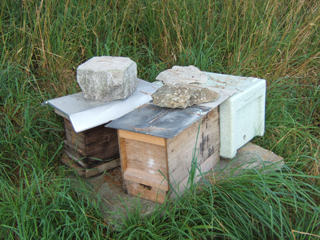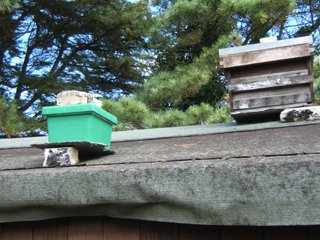 On and on the hot weather goes – and on and on the bees go, gathering nectar, expanding dramatically, swarming, and making life very busy for all beekeepers. Whilst things have settled down over the past month with regard to swarming, there has still been a need to check that swarmed colonies have re-queened satisfactorily and that the new queens have mated properly. Strange to relate, four of my colonies which either swarmed or had queen-right nuclei removed from them to forestall swarming, ended up with drone-laying queens (i.e.: unmated) or becoming queen-less (where the queen has either been rejected or has failed to return from a mating flight).
On and on the hot weather goes – and on and on the bees go, gathering nectar, expanding dramatically, swarming, and making life very busy for all beekeepers. Whilst things have settled down over the past month with regard to swarming, there has still been a need to check that swarmed colonies have re-queened satisfactorily and that the new queens have mated properly. Strange to relate, four of my colonies which either swarmed or had queen-right nuclei removed from them to forestall swarming, ended up with drone-laying queens (i.e.: unmated) or becoming queen-less (where the queen has either been rejected or has failed to return from a mating flight).
This has just added an extra level of complication to my beekeeping this year, as I then have to find or raise queens to put in the place of the lost or unmated ones. So far, I’m just about level-pegging with the bees but come August, I will have to start thinking about uniting colonies to make them strong enough in bee numbers for the coming winter. This will be done after the honey crop has been taken (though I shouldn’t count my honey jars until the honey has been removed from the hives – a bit like chickens and eggs!) and after treatment for Varroa. So another busy period lies ahead which the bees will do their best to make as awkward as possible for me, I’m sure.
 Other activities that take up my time at the moment are checking nuclei to see when they should be moved into a full-sized hive, checking those that I am selling to ensure the laying pattern of the new queen is satisfactory, and ensuring existing production colonies have enough space for storage of the nectar brought in and for the honey produced from that nectar. Nectar requires three times the storage space of honey, as it contains about 80{c8c3b3d140ed11cb7662417ff7b2dc686ffa9c2daf0848ac14f76e68f36d0c20} water in its unprocessed state and is brought in rapidly when there is a “flow” on, so it is vital to ensure there is enough space for both products, otherwise the bees might well decide to swarm again to somewhere which in their view has more space.
Other activities that take up my time at the moment are checking nuclei to see when they should be moved into a full-sized hive, checking those that I am selling to ensure the laying pattern of the new queen is satisfactory, and ensuring existing production colonies have enough space for storage of the nectar brought in and for the honey produced from that nectar. Nectar requires three times the storage space of honey, as it contains about 80{c8c3b3d140ed11cb7662417ff7b2dc686ffa9c2daf0848ac14f76e68f36d0c20} water in its unprocessed state and is brought in rapidly when there is a “flow” on, so it is vital to ensure there is enough space for both products, otherwise the bees might well decide to swarm again to somewhere which in their view has more space.
Congestion is one of the main triggers for swarming – if congestion can be controlled properly, the likelihood (and need) for swarming can be substantially reduced. What I therefore tend to do from time to time at this time of year is remove two or three combs of honey from one or more of the supers on each hive, thereby offering freed storage space without expanding the size of the hive volume the bees must keep warm. I have been able to take some of the main (summer) crop of honey already by doing this and have been rewarded with some lovely combs of natural honey which, instead of extracting the honey from the comb, I have cut up into sections of “cut comb”.
 This is honey in its most natural state – as the bees left it – and it tastes delicious! Also, whilst the honey flow is in full force at the moment, the days are becoming marginally shorter and so the queen is starting to lay fewer eggs, thereby freeing up space in the brood box, so some of the incoming nectar goes into that released space for processing, therefore taking the pressure off storage requirements in the supers. It’s just finding that balance between too large a hive and too little storage space.
This is honey in its most natural state – as the bees left it – and it tastes delicious! Also, whilst the honey flow is in full force at the moment, the days are becoming marginally shorter and so the queen is starting to lay fewer eggs, thereby freeing up space in the brood box, so some of the incoming nectar goes into that released space for processing, therefore taking the pressure off storage requirements in the supers. It’s just finding that balance between too large a hive and too little storage space.
Last month I told you that I had been re-queening those of my hives headed by Italian queens with Cornish black queens. As part of a Cornish project looking into the characteristics of these Cornish black queens, I clipped the wing of one of these queens so that the wing could be analysed using morphometric techniques. I don’t normally clip my queens’ wings, though some beekeepers do so to prevent loss of bees during swarming. I prefer to manage my bees to minimise the likelihood of swarming, and if they do swarm then I place bait hives around the apiary to offer them a new home within my control. I also collected about 30 workers from the same colony for similar analysis by the project coordinators. It will be interesting to see the results when the job is done.
I recently noticed that yet another of the swarms I had taken quite recently (not one of mine this time!), had an Italian queen! This shows just how common Italian queens are in Cornwall – they are readily available from beekeeping suppliers and are bought in by many beekeepers to replace lost queens or lost colonies, whereas the British Beekeepers’ Association recommendation is for the breeding of local queens as opposed to the buying in of “foreign” material. So another re-queening exercise needs to be done, though it might not happen until next year now.
 Those colonies already re-queened appear to have settled down and to have accepted their new monarch without any problems. It is interesting to see the change in the dynamics of the colony once the new queen takes over. Whereas flying might have been half-hearted before, it suddenly becomes a lot more energised and purposeful, as it does when a virgin queen is introduced to a queen-less colony. It is this vigour that will stand a colony in good stead in its preparations for winter.
Those colonies already re-queened appear to have settled down and to have accepted their new monarch without any problems. It is interesting to see the change in the dynamics of the colony once the new queen takes over. Whereas flying might have been half-hearted before, it suddenly becomes a lot more energised and purposeful, as it does when a virgin queen is introduced to a queen-less colony. It is this vigour that will stand a colony in good stead in its preparations for winter.
By next month I should have removed any honey crop and started treating my bees for Varroa, so I will report back on both topics later. In the meantime, continue to keep an eye out for swarms – they can occur as late as September, though it is unusual to be that late as the colony would not have time to establish before the winter sets in.
Colin Rees – 01872 501313 – colinbeeman@aol.com

